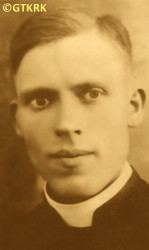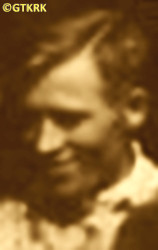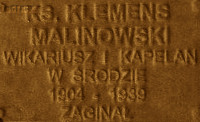Roman Catholic
St Sigismund parish
05-507 Słomczyn
85 Wiślana Str.
Konstancin deanery
Warsaw archdiocese, Poland
full list:
displayClick to display full list

searchClick to search full list by categories
wyświetlKliknij by wyświetlić pełną listę po polsku

szukajKliknij by przeszukać listę wg kategorii po polsku

Martyrology of the clergy — Poland
XX century (1914 – 1989)
personal data
surname
MALINOWSKI
forename(s)
Clement (pl. Klemens)
function
diocesan priest
creed
Latin (Roman Catholic) Church RCmore on
en.wikipedia.org
[access: 2014.09.21]
diocese / province
Gniezno and Poznań archdiocese (aeque principaliter)more on
www.archpoznan.pl
[access: 2012.11.23]
RC Military Ordinariate of Polandmore on
en.wikipedia.org
[access: 2014.12.20]
date and place
of death
04.1940

NKVD MinskHQ at 17 Sovetskaya Str.
today: 17 Independence Str., Minsk dist., Minsk city reg., Belarus
more on
en.wikipedia.org
[access: 2025.02.17]
alt. dates and places
of death
05.1940, 06.1940, 09.1939
NKVD TverHQ at 17 4 Sovetskaya Str
today: Tver Medical Institute, Tver oblast, Russia
more on
en.wikipedia.org
[access: 2021.10.09]
Stegna foresttoday: Stegna gm., Nowy Dwór Gdański pov., Pomerania voiv., Poland
more on
en.wikipedia.org
[access: 2022.01.28]
details of death
From 01.01.1939 reserve chaplain of the Polish Armed Forces.
After German invasion of Poland on 01.09.1939 (Russians invaded Poland 17 days later) and start of the World War II, started his ministry in Polish Army as its chaplain on 02.09.1939.
Lost in the autumn 1939, prob. on the territories occupied by Russians where withdrew with his unit under German pressure.
Prob. arrested by the Russians.
Prob. murdered in 04‐06.1940 as part of the «Katyn genocide», prob. in Minsk, as one of the victims of the still unknown so‐called «Belarusian Katyn list», and his body was buried in the Kuropaty forest.
alt. details of death
Might have been sent to KLW Ostashkov concentration camp in Ostaszków. From there was taken to an execution site inTver and murdered.
According to other sources killed at the beginning of 09.1939 by the Germans (n. Środa Wlkp.?, in Stegna forest?).
cause of death
mass murder
perpetrators
Germans / Russians
sites and events
NKVD MinskClick to display the description, KurapatyClick to display the description, NKVD TverClick to display the description, «Katyn genocide 1940»Click to display the description, KLW OstashkovClick to display the description, KL StutthofClick to display the description, Ribbentrop‐MolotovClick to display the description, Pius XI's encyclicalsClick to display the description
date and place
of birth
27.10.1904Birth certification on:
metryki.genealodzy.pl
[access: 2025.08.19]

Maurycatoday: Łask gm., Łask pov., Łódź voiv., Poland
more on
en.wikipedia.org
[access: 2022.01.28]
parents
MALINOWSKI Michael
🞲 ?, ? — 🕆 ?, ?

GABRYAŃCZYK Constance
🞲 ?, ? — 🕆 ?, ?
baptism
30.10.1904Birth certification on:
metryki.genealodzy.pl
[access: 2025.08.19]

Łasktoday: Łask gm., Łask pov., Łódź voiv., Poland
more on
en.wikipedia.org
[access: 2020.11.01]
Immaculate Conception of the Blessed Virgin Mary and St Michael the Archangel RC collegiate church
presbyter (holy orders)
ordination
12.06.1932

Poznańtoday: Poznań city pov., Greater Poland voiv., Poland
more on
en.wikipedia.org
[access: 2021.07.18]
St Peter and St Paul the Apostles RC archcathedral churchmore on
en.wikipedia.org
[access: 2025.03.14]
positions held
1939
vicar — Środatoday: Środa Wielkopolska, Środa Wielkopolska gm., Środa Wielkopolska pov., Greater Poland voiv., Poland
more on
en.wikipedia.org
[access: 2021.06.20] ⋄ Assumption of the Blessed Virgin Mary RC collegiate parish ⋄ Środatoday: Środa Wielkopolska, Środa Wielkopolska gm., Środa Wielkopolska pov., Greater Poland voiv., Poland
more on
en.wikipedia.org
[access: 2021.06.20] RC deanery
1937 – 1939
vicar — Janków Zaleśnytoday: Raszków gm., Ostrów Wielkopolski pov., Greater Poland voiv., Poland
more on
en.wikipedia.org
[access: 2021.07.18] ⋄ St Adalbert the Bishop and Martyr and Nativity of the Blessed Virgin Mary RC parish ⋄ Ostrów Wielkopolskitoday: Ostrów Wielkopolski urban gm., Ostrów Wielkopolski pov., Greater Poland voiv., Poland
more on
en.wikipedia.org
[access: 2021.06.07] RC deanery
c. 1936 – 1937
vicar — Poznańtoday: Poznań city pov., Greater Poland voiv., Poland
more on
en.wikipedia.org
[access: 2021.07.18] ⋄ RC parish
1933 – c. 1936
vicar — Modrzetoday: Stęszew gm., Poznań pov., Greater Poland voiv., Poland
more on
en.wikipedia.org
[access: 2021.06.20] ⋄ St Giles the Abbot RC parish ⋄ Stęszewtoday: Stęszew gm., Stęszew pov., Greater Poland voiv., Poland
more on
en.wikipedia.org
[access: 2021.06.20] RC deanery
1932 – 1933
vicar — Granowotoday: Granowo gm., Grodzisk Wielkopolski pov., Greater Poland voiv., Poland
more on
en.wikipedia.org
[access: 2022.02.03] ⋄ St Martin the Bishop and Confessor RC parish ⋄ Grodzisk Wielkopolskitoday: Grodzisk Wielkopolski gm., Grodzisk Wielkopolski pov., Greater Poland voiv., Poland
more on
en.wikipedia.org
[access: 2021.07.18] RC deanery
1929 – 1932
student — Poznańtoday: Poznań city pov., Greater Poland voiv., Poland
more on
en.wikipedia.org
[access: 2021.07.18] ⋄ philosophy and theology, Archbishop's Theological Seminary (Collegium Leoninum)
till 1929
student — Gnieznotoday: Gniezno urban gm., Gniezno pov., Greater Poland voiv., Poland
more on
en.wikipedia.org
[access: 2021.12.18] ⋄ philosophy, Archbishop's Theological Seminary
others related
in death
CIEŚLAClick to display biography Felix, JASTRZĘBSKIClick to display biography Stanislav, KUREKClick to display biography Stanislav, STANISŁAWSKIClick to display biography Steven Thaddeus, SZCZERBICKIClick to display biography Fabian, SZUMOWSKIClick to display biography Marian Richard, ŻURAWSKIClick to display biography Ceslav, ŻYLIŃSKIClick to display biography Boleslav
sites and events
descriptions
NKVD Minsk: In 04‐05.1940, the Russian genocidal NKVD organization shot in Belarus — as part of the «Katyn genocide of 1940» — c. 3,870 Poles (according to some assumptions, there could have been as many as 4,465). This genocide was the implementation of the decision of the Russian Commie‐Nazi authorities — the Politburo of the Russian Commie‐Nazi party — of 05.03.1940 to exterminate tens of thousands of Polish intelligentsia and servicemen held in Russian camps, established after the German‐Russian Ribbentrop‐Molotov Agreement and the annexation of half of Poland by the Russians in 1939. After the formal „verdict”, the NKVD Special Council in Moscow, i.e. the genocidal Russian kangaroo court known as the «NKVD Troika» sent disposition letters to the NKVD in Belarus, containing the names of people to be murdered. In order to implement this, the head of the NKVD, Lavrentiy Beria, issued on 22.03.1940 order No. 00350 on the „unloading of NKVD prisons”, ordering the transport of convicts from several smaller prisons in Belarus to Minsk. The given number of victims — 3,870 — is a number calculated on the basis of a handwritten note by Alexander Shelepin, then head of the Russian KGB, who wrote on 03.03.1959 that in 1940 7,305 Poles were executed from camps and prisons in Ukraine and Belarus; and on the basis of the so‐called «Ukrainian Katyn List» («Cvetukhin list») of 25.11.1940, containing 3,435 names of people murdered in Ukraine. The aforementioned disposition lists are not known — it is not even known how many there were: from other known such lists of the «Katyn genocide» it can be concluded that there were at least 9 of them, and probably many times more. Therefore, the people who were murdered are not known. Among them were prob. many of the 1,996 people known by name, transported in early 1940 from NKVD prisons in Belarus to Minsk, including from Brest (c. 1,500 people), Pinsk (c. 500), Baranavychi (c. 450), although not all of them. The victims were prob. murdered in Minsk, Belarus, in the internal prison of the Belarusian NKVD headquarters at 17 Sovetskaya Str. (today 17 Independence Street) or in the nearby prison known as „Vołodarka”, in the Pishchalauski Castle at Volodarsky Street, in soundproof basements, one by one, by the so‐called Katyn method, with a pistol shot to the back of the head. The bodies were mostly buried in pits in the Kuropaty forest near Minsk. To this day, neither the Russians nor the Belarusians have released detailed protocols of this genocide in their possession. (more on: en.wikipedia.orgClick to attempt to display webpage
[access: 2025.02.18])
Kurapaty: Forest near Minsk in Belarus, where mass graves of victims murdered by the Russian genocidal NKVD organization in the years 1937—1941 were discovered. It is also the place where these murders were carried out — in addition to human remains, shell casings and bullets were also discovered there. The NKVD genociders brought there, in closed cars, convicts and shot them there. Murders were also carried out in other places in Minsk, including prob. of Poles — as part of the «Katyn Genocide 1940», and their bodies were supposedly buried in Kurapaty. Estimates of the number of murdered range from 7,000 (the version of the Prosecutor General of Belarus) to 250,000 or even more. For decades, the Belarusian authorities have been sabotaging efforts to thoroughly investigate the site of the genocide. The archives are classified. In school textbooks published in Belarus after 2000 there is not a word about Kurapaty. (more on: en.wikipedia.orgClick to attempt to display webpage
[access: 2023.01.18])
NKVD Tver: On 04.04‐22.05.1940 the Russians executed in NKVD HQ building at 4 Sovetskaya Str (now Tver Medical Institute) in Tver c. 6,314 Polish prisoners of war (POW) kept in KLW Ostashkov concentration camp in Ostashkov. This genocide was the implementation of the decision of the Russian Commie‐Nazi authorities — the Politburo of the Russian Commie‐Nazi party — of 05.03.1940 to exterminate tens of thousands of Polish intelligentsia and servicemen, held in Russian camps established after the German‐Russian Ribbentrop‐Molotov Agreement and the annexation of half of Poland by the Russians in 1939, known as «Katyn genocide». After the formal „verdict”, the NKVD Special Council Moscow, i.e. the genocidal Russian kangaroo court known as the «NKVD Troika», sent successive disposition letters to the NKVD in Tver — there were c. 60 of them — containing the names of the persons to be murdered. The prisoners were brought — Tver is c. 190 km from Ostashkov — to the NKVD HQ building, identified one by one in a basement room known as the „Lenin’s room”, handcuffed, taken to another room cellar with a door covered with felt, and then murdered individually by a shot from a German Walther P38 pistol into the back of the head. The bodies where next dumped into mass graves in ditches in the Miednoje forest, in the NKVD summer resort, and covered with sand by an excavator. (more on: pl.wikipedia.orgClick to attempt to display webpage
[access: 2012.11.23], en.wikipedia.orgClick to attempt to display webpage
[access: 2014.05.09])
«Katyn genocide 1940»: 05.03.1940, the Russian Commie‐Nazi authorities — the Politburo of the Russian Commie‐Nazi party headed by Joseph Stalin — made a formal, secret decision No. P13/144 to exterminate tens of thousands of Polish intelligentsia and military personnel, „declared and hopeless enemies of the Russian government”, held in Russian camps, as a consequence of the German‐Russian Ribbentrop‐Molotov Agreement, the invasion of Poland and annexation of half of Poland in 09.1939, and the beginning of World War II. The decision was, as it were, „sanctioned” by the verdicts of the NKVD Special Council, i.e. the genocidal Russian kangaroo court known as «NKVD Troika» in Moscow. The implementation in Ukraine and Belarus was made possible by order No. 00350 of 22.03.1940 of the head of the NKVD, Lavrentiy Beria, on the „unloading of NKVD prisons”, i.e. transfer of prisoners from several prisons in Ukraine and Belarus to central prisons, e.g. in Kiev or Minsk. The genocidal «NKVD Troika», after issuing sentences, also sent to local NKVD units, NKVD disposition lists — i.e. lists of convicts — each containing on average c. 100 names. Named lists are known — may be reconstructed — for people held in the KLW Kozelsk and KLW Ostashkov camps, but not for KLW Starobilsk, known for victims from Ukrainian prisons, but not Belarusian ones. It is not even known exactly how many lists there were, mainly because the number of them sent to the NKVD in Belarus is unknown. On 03.03.1959 Alexander Shelepin, then head of the Russian KGB, in a handwritten note stated: „ Since 1940, the Committee for State Security under the Council of Ministers of Russia, has been keeping records and other materials relating to the prisoners of war and interned officers, gendarmes, policemen, etc., people from former bourgeois Poland shot that year. In total, based on the decision of the special troika of the NKVD of the USSR, 21,857 people were shot, of whom: 4,421 people in the Katyn Forest (Smolensk Oblast), 3,820 people from the Starobilsk camp near Kharkov, 6,311 people from the Ostashkov camp (Kalinin Oblast), and 7,305 people in other camps and prisons in Western Ukraine and Western Belarus. The entire operation of liquidation of the above–mentioned was carried out on the basis of the Resolution of the Central Committee of the CPSU of 05.03.1940”. The head of the NKVD recommended to the Russian leader, Nikita Khrushchev, to destroy all personal files of those shot in 1940, but to keep the minutes of the meetings of the «NKVD Troika» and confirmations of the implementation of the decisions of the «NKVD Troika». A one–sentence draft resolution was attached to the note. It is not known whether the resolution was accepted and whether the files were destroyed. The aforementioned protocols and confirmations of the «NKVD Troika» are also not known. There are indications — i.e. four so‐called „NKVD‐Gestapo Methodical Conferences” of 1939‐1940: in Brest on Bug, Przemyśl, Zakopane and Cracow — of close collaboration between Germans and Russians in realization of plans of total extermination of Polish nation, its elites in particular — decision that prob. was confirmed during meeting of socialist leaders of Germany: Mr Heinrich Himmler, and Russia: Mr Lavrentyi Beria, in another German leader, Mr Hermann Göring, hunting lodge in Rominty in Romincka Forest in East Prussia. (more on: en.wikipedia.orgClick to attempt to display webpage
[access: 2023.12.15])
KLW Ostashkov: Russian Rus. Концентрационный Лагерь для Военнопленных (Eng. POW Concentration Camp) KLW, run by genocidal Russian NKVD organization, for Poles arrested after the invasion in 1939, operating in 1939‐1940 in Ostashkov — in practice on Seliger lake Stolbnoy island and Svetlitsa peninsula, c. 11 km from Ostashkov, in a former Orthodox monastery, Niłowo‐Stołobieńska Hermitage, looted and shut down by Russian Bolsheviks in 1928. In 04.1940 6,570 were held captive there (in 11.1940 — 8397), out of which c. 6,300 were subsequently — as the fulfillment of Russian government decision to exterminate Polish intelligentsia and prisoners of war camps (Polish holocaust) — executed in Tver. Among the victims were officers of the Polish State Police, the Border Protection Corps KOP, Military Police, the Prison Service, officers and soldiers of the Polish Army, intelligence and counterintelligence officers of the Second Department of the General Staff, priests, employees of the judiciary, the fire brigade, foresters and military settlers from the eastern part of the Second Polish Republic. On another island of Lake Seliger, Gorodomla, in 1946‐1953 the Russians held a group of German specialists from Wernher von Braun's team, who, under the direction of Sergei Korolev, worked on Russian missiles. (more on: pl.wikipedia.orgClick to attempt to display webpage
[access: 2012.11.23])
KL Stutthof: In German Germ. Konzentrationslager (Eng. concentration camp) KL Stutthof (then in Eastern Prussian belonging to Germany, today: Sztutowo village) concentration camp, that Germans started to build on 02.09.1939, a day after German invasion of Poland and start of the World War II, Germans held c. 110,000‐127,000 prisoners from 28 countries, including 49,000 women and children. C. 65,000 victims were murdered and exterminated. In the period of 25.01‐27.04.1945 in the face of approaching Russian army Germans evacuated the camp. When on 09.05.1945 Russians soldiers entered the camp only 100 prisoners were still there. In an initial period (1939‐1940) Polish Catholic priests from Pomerania were held captive there before being transported to KL Dachau concentration camp. Some of them were murdered in KL Stutthof or vicinity (for instance in Stegna forest). Also later some Catholic priests were held in KL Stutthof. (more on: stutthof.orgClick to attempt to display webpage
[access: 2018.11.18], en.wikipedia.orgClick to attempt to display webpage
[access: 2013.07.06])
Ribbentrop‐Molotov: Genocidal Russian‐German alliance pact between Russian leader Joseph Stalin and German leader Adolf Hitler signed on 23.08.1939 in Moscow by respective foreign ministers, Mr. Vyacheslav Molotov for Russia and Joachim von Ribbentrop for Germany. The pact sanctioned and was the direct cause of joint Russian and German invasion of Poland and the outbreak of the World War II in 09.1939. In a political sense, the pact was an attempt to restore the status quo ante before 1914, with one exception, namely the „commercial” exchange of the so‐called „Kingdom of Poland”, which in 1914 was part of the Russian Empire, fore Eastern Galicia (today's western Ukraine), in 1914 belonging to the Austro‐Hungarian Empire. Galicia, including Lviv, was to be taken over by the Russians, the „Kingdom of Poland” — under the name of the General Governorate — Germany. The resultant „war was one of the greatest calamities and dramas of humanity in history, for two atheistic and anti‐Christian ideologies — national and international socialism — rejected God and His fifth Decalogue commandment: Thou shall not kill!” (Abp Stanislav Gądecki, 01.09.2019). The decisions taken — backed up by the betrayal of the formal allies of Poland, France and Germany, which on 12.09.1939, at a joint conference in Abbeville, decided not to provide aid to attacked Poland and not to take military action against Germany (a clear breach of treaty obligations with Poland) — were on 28.09.1939 slightly altered and made more precise when a treaty on „German‐Russian boundaries and friendship” was agreed by the same murderous signatories. One of its findings was establishment of spheres of influence in Central and Eastern Europe and in consequence IV partition of Poland. In one of its secret annexes agreed, that: „the Signatories will not tolerate on its respective territories any Polish propaganda that affects the territory of the other Side. On their respective territories they will suppress all such propaganda and inform each other of the measures taken to accomplish it”. The agreements resulted in a series of meeting between two genocidal organization representing both sides — German Gestapo and Russian NKVD when coordination of efforts to exterminate Polish intelligentsia and Polish leading classes (in Germany called «Intelligenzaktion», in Russia took the form of Katyń massacres) where discussed. Resulted in deaths of hundreds of thousands of Polish intelligentsia, including thousands of priests presented here, and tens of millions of ordinary people,. The results of this Russian‐German pact lasted till 1989 and are still in evidence even today. (more on: en.wikipedia.orgClick to attempt to display webpage
[access: 2015.09.30])
Pius XI's encyclicals: Facing the creation of two totalitarian systems in Europe, which seemed to compete with each other, though there were more similarities than contradictions between them, Pope Pius XI issued in 03.1937 (within 5 days) two encyclicals. In the „Mit brennender Sorge” (Eng. „With Burning Concern”) published on 14.03.1938, condemned the national socialism prevailing in Germany. The Pope wrote: „Whoever, following the old Germanic‐pre‐Christian beliefs, puts various impersonal fate in the place of a personal God, denies the wisdom of God and Providence […], whoever exalts earthly values: race or nation, or state, or state system, representatives of state power or other fundamental values of human society, […] and makes them the highest standard of all values, including religious ones, and idolizes them, this one […] is far from true faith in God and from a worldview corresponding to such faith”. On 19.03.1937, published „Divini Redemptoris” (Eng. „Divine Redeemer”), in which criticized Russian communism, dialectical materialism and the class struggle theory. The Pope wrote: „Communism deprives man of freedom, and therefore the spiritual basis of all life norms. It deprives the human person of all his dignity and any moral support with which he could resist the onslaught of blind passions […] This is the new gospel that Bolshevik and godless communism preaches as a message of salvation and redemption of humanity”… Pius XI demanded that the established human law be subjected to the natural law of God , recommended the implementation of the ideal of a Christian state and society, and called on Catholics to resist. Two years later, National Socialist Germany and Communist Russia came together and started World War II. (more on: www.vatican.vaClick to attempt to display webpage
[access: 2023.05.28], www.vatican.vaClick to attempt to display webpage
[access: 2023.05.28])
sources
personal:
www.ordynariat.wp.mil.plClick to attempt to display webpage
[access: 2012.11.23], www.bractwo-wiezienne.warszawa.plClick to attempt to display webpage
[access: 2013.01.17], metryki.genealodzy.plClick to attempt to display webpage
[access: 2025.08.19], www.wtg-gniazdo.orgClick to attempt to display webpage
[access: 2013.07.06]
original images:
www.facebook.comClick to attempt to display webpage
[access: 2023.12.01], www.ordynariat.wp.mil.plClick to attempt to display webpage
[access: 2012.11.23], www.facebook.comClick to attempt to display webpage
[access: 2023.12.01], www.facebook.comClick to attempt to display webpage
[access: 2023.12.01], www.katedrapolowa.plClick to attempt to display webpage
[access: 2014.01.16]
LETTER to CUSTODIAN/ADMINISTRATOR
If you have an Email client on your communicator/computer — such as Mozilla Thunderbird, Windows Mail or Microsoft Outlook, described at WikipediaPatrz:
en.wikipedia.org, among others — try the link below, please:
LETTER to CUSTODIAN/ADMINISTRATORClick and try to call your own Email client
If however you do not run such a client or the above link is not active please send an email to the Custodian/Administrator using your account — in your customary email/correspondence engine — at the following address:

giving the following as the subject:
MARTYROLOGY: MALINOWSKI Clement
To return to the biography press below:
 Click to return to biography
Click to return to biography
















